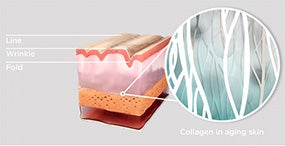
This article explains why collagen is a key protein for maintaining a youthful appearance and what you can do to prevent and treat typical signs of collagen loss such as wrinkles, deep folds and saggy skin.
What is collagen?
Collagen is the most abundant protein in our bodies. It gives structure and support to the connective tissue all throughout the body—to bone, cartilage, ligaments, muscles, blood vessels and skin, to name a few. The connective tissue literary holds our bodies together.
Collagen can be both rigid, such as in bones, cartilage and teeth, or compliant, such as in tendons and skin.
The collagen in your skin
The collagen in the skin is primarily found in the dermis. The dermis is the middle layer of the skin, which is below the so-called epidermis (the outer layer) and above the hypodermis (the bottom layer), which contains fat cells.
Collagen is one of the three building blocks in the dermis that provide skin volume, elasticity and softness:
- Collagen: the fibrous collagen proteins provide structure and support
- Elastin: an elastic protein that maintains skin shape
- Hyaluronic acid: a gel-like substance that preserves skin hydration
Since collagen makes up the skin’s structure and support, more collagen enables the presence of more elastin and hyaluronic acid. Consequently, loss of collagen is one of the primary reasons for visible facial aging, such as saggy skin and wrinkles.
Why does the collagen content in the skin decrease with age?
Facial aging begins in your 20s and is due to both internal factors (genetics and natural aging) and external factors (sun exposure, stress, smoking etc.).[1] As the skin ages, the natural loss of collagen leads to thinner and structurally weakened skin.[2,3]
By the age of 40, most people have 20 percent collagen loss and by the age of 50 up to 30 percent collagen loss.[4]
Saggy skin, deep folds and wrinkles start to appear
With the loss of collagen, visible signs of aging—saggy skin, deep folds and wrinkles—will start to appear. There are also other changes that occur with aging that will influence facial skin, for example loss of subcutaneous fat in the hypodermis and bone resorption. These other changes could make saggy skin more noticeable as well as further aggravate folds and wrinkles.
The images below illustrate the loss of support and structure in aging skin compared to young skin.
As the images show, aging skin has less support from collagen, which is partly the reason for saggy skin and why wrinkles and folds start to appear.
Preventing collagen loss
You can prevent collagen loss by avoiding exaggerated sun exposure and other life-style factors that have a negative impact on skin collagen such as smoking, alcohol and stress.
It is difficult to restore the collagen content of the skin by treating it from the outside. Collagen molecules are too large to penetrate the dermis and will only form a temporary layer on the skin surface.
Treatments that stimulate collagen synthesis in the skin
As collagen is such a key component for healthy and youthful skin, there are a number of different treatments that aim to stimulate collagen synthesis in the skin.
Laser skin resurfacing, microdermabration, microneedling, ultrasound and radio-frequency are all treatments that purport to stimulate skin renewal by causing a trauma, or a controlled injury. The trauma will trigger a healing process that is supposed to rejuvenate the skin and reduce the appearance of saggy skin and wrinkles. Depending on the degree of trauma, there will be certain risks associated with the treatments.
There are also biostimulators that have a different mode of action. Biostimulators use specific substances that are injected in the deep dermis where they will activate collagen synthesis. Different products use different kinds of substances for this activation. They are biodegradable and will disappear from the skin with time. Biostimulators restore the skin structure gradually over time. Also biostimulators carry the risk of side effects, although they do not use trauma to stimulate collagen renewal.
Continue reading: Collagen treatments
There are many different kinds of collagen treatments and skin renewal treatments on the market. The following articles will give you a better understanding of available options and which treatment will be best for you:
In this article you can read about different collagen treatments—mode of action, risks and benefits: How effective are aesthetic treatments for collagen stimulation?
This article explains how biostimulators activate the natural collagen production in your skin: How to restore aged skin with a collagen biostimulator
REREFENCES:
- Vleggaar D, Fitzgerald R. Dermatological implications of skin aging: a focus on supraperiosteal volumization for perioral rejuvenation. J Drugs Dermatol. 2008;7:209-220.
- Farage MA et al. Adv Wound Care (New Rochelle) 2013;2(1):5–10.;
- Quan T and Fisher GJ. Gerontology 2015; 61(5):427–34
- Shuster S, Black MM, McVitie E. The influence of age and sex on skin thickness, skin collagen and density. Br J Dermatol. 1975;93:639-643.



